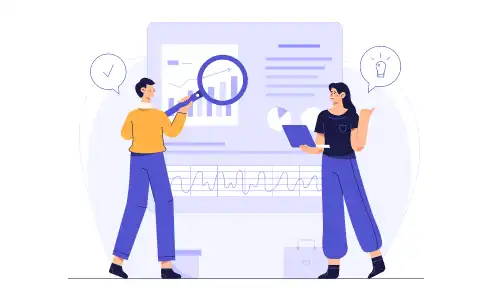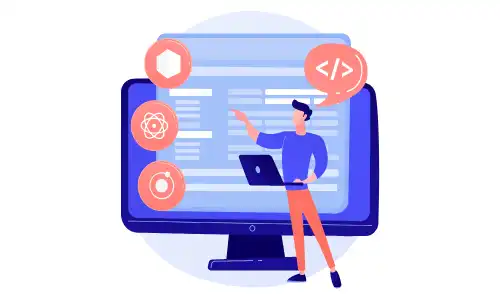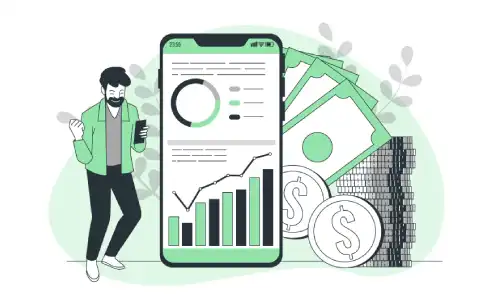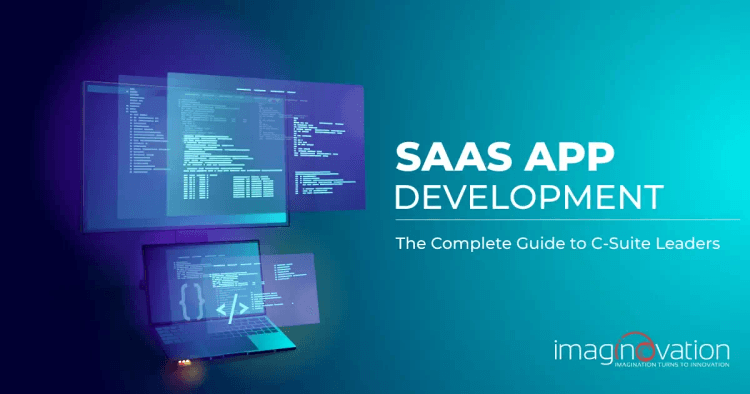In the ever-evolving landscape of business technology, leaders like you wield the power to drive innovation and growth. At the heart of this digital transformation lies an essential strategic choice: SaaS development.
As a C-suite executive, you understand the significance of staying ahead in the technology curve. This guide is tailored exclusively for leaders like you, offering a comprehensive dive into the fundamentals of SaaS development.
We'll navigate through the intricate world of Software as a Service (SaaS), from its inception to deployment, demystifying every step along the way.
Curious about how SaaS can transform your business? Let's embark on this journey into SaaS Development 101, where knowledge empowers you to shape the future of your organization.
What is SaaS?
Software as a service (SaaS) is a cloud-based software in which the cloud provider hosts applications and then makes them available to users over the Internet.
The software distribution model allows data to be accessed from any device. What would a user need? All one will need is to have an internet connection and a web browser.
Plus, in this web-based model, one will find independent software vendors (ISV) contracting with third-party cloud providers for hosting and maintaining the services, databases, and code that makes up an application.
SaaS is one of the main categories of cloud computing, and the good part—SaaS solutions are marketed to both business-to-business (B2B) and business to consumers (B2C) users.
According to a McKinsey & Company report, analysts highlight further growth in the SaaS market. Moreover, experts expect to see the need for SaaS products touching $200 billion by 2024.
How to Create a Successful SaaS Application?
What’s next? It’s prudent to start creating an app by formulating a core value proposition for your SaaS. Here are some facets that may help you.
1. Research Insights
As an appreneur, it would be good to start with grounded research. You can think of:
- Customer research
- Market research
- Competitor’s research
The insights based on research can give you a more precise picture of the market demand. Plus, it also helps during the development of the MVP of your SaaS platform.
So, if you look at it, this phase is critical as, without this phase, you will invest in the development of software that probably has a void market. Before getting into the app development phase, it is pertinent to research all three facets.

The insights that will help you from your research may include:
- The size of the market.
- The nature of demand for a new product.
- The customer’s pain points.
- How are the pain points resolved by your competitors or in the market?
- Your competitor's USP.
- The software or applications that are available in the market.
The collated data can be a good base for developing your SaaS application. After the data collection stage, you can prioritize features with your development team.
Next, start with your MVP development. When it comes to streamlining features for your SaaS platform, they can typically be placed in three buckets, including:
- Analytical tools. You can think of CRM systems like Hubspot, where you may want to develop an intelligent dashboard with reports, graphics, and statistics.
- Functional tools. Consider the visual editor and cloud platform Canva, with plenty of editorial features and filters.
- Management of accounts. With this feature, you can differentiate customers’ roles, plans, and sets of features they could use.
With the initial discovery phase of the project in place, you can move next to the SaaS app development phase. Here is a step-by-step process of application development of your SaaS.
Also Read: How Do You Know If Your SaaS Application Concept will be Profitable?
2. SaaS Application Development Framework
Now, it is time to consider the development stage of your SaaS app. You may follow the standard software development stages, which include:
- Business Analysis. This stage will involve collecting product requirements and building user journeys.
- Design. Here, the design team can creatively develop a rational UI/UX design that’s minimalistic and elegant, keeping your target customer in mind.
- Development. It is an excellent stage to consider developing an app with the SaaS software’s MVP features. You can always consider integrations at the end of the process. Plus, you will need to keep track of the development costs at this stage constantly.
- Testing and Quality Assurance. The testing stage is critical to your product’s performance and smooth operations. Here the testing team ensures that everything works well; it is also a great idea to adopt an agile way of testing your outcomes at each iteration and getting more optimal results.
- Product Maintenance. The maintenance stage is vital, as it helps to keep up with the market requirements and changing trends. It also helps to fix any glitches immediately, augmenting the user experience.
To create a valuable SaaS platform, remember to focus on a high-quality UX. Here are some quick tips to keep in mind during your SaaS app development stage.

a. Pay attention to scalability
Why is it critical to pay attention to the scalability of the backend of your SaaS app? Here’s an interesting statistic for you.
The global market for SaaS products will likely be $220.21 billion in 2022. Experts estimate a 13.1% CAGR between then and 2022. The data makes it quite clear that it is a growing market. (Source:)
So, as an appreneur, it will be beneficial to proactively plan to grow your infrastructure and software architecture.
A scalable backend for your SaaS product is the key to acquiring more customers without affecting performance. Eventually, as you grow your customer base, you will find a boost in revenue.
What can you do?
- Innovate around your functional features.
- Implement scalability-related measures right from the beginning.
- Measure metrics like CPU usage, memory utilization, network I/O, and more.
- Choose the apt scalable technology stage. For example: When developing a web app, Node.js can help you make it scalable.
b. Implementing a queuing system
You will also need a system that helps users interact with a platform and APIs simultaneously (aka asynchronous communication protocol.) So, each system can work with receivers, senders, and messages.
The protocol can allow each user to send a data request to a system and receive a result. Thus, message queuing can help each user run a SaaS at different times. Plus, it can help communicate with integrations and other services.
c. Work on an integration approach
Picture this! You have your version of the SaaS software solution. One of the expectations is to have a smooth migration from one software to another, ensuring that you don’t experience data loss.
A well-designed integration approach can ensure new software integration in the existing business process. Plus, it will enable smooth data exchange.
3. SaaS Development Tech Stack
Next, you will need to choose the apt technologies and SaaS development tools. It is essential to choose to curate your product wisely for a seamless experience.
Here are some stack options, which you can choose from for developing a SaaS application.
Table 1. The Best Tech Stack
| Backend/Frontend | System Type | Technologies |
|---|---|---|
| Backend | Server | nGinx, Apache |
| App Server | Node.js | |
| Framework | Laravel | |
| Databases | MySQL, PostgreSQL, Redis, MongoDB | |
| Hostings | AWS, Vultr | |
| Frontend | Libraries | Vue.js, React |
| Languages | JS, HTML 5, CSS 3 | |
| Mobile Frameworks | Flutter, React Native, Swift, Objective-C, Kotlin, Java |
Building a SaaS app for a growing business can face unusual challenges [keep reading to find out more about SaaS challenges].
However, if you take steps sensibly, you can achieve phenomenal results and outperform your peers. If you are wondering about some SaaS benefits, here’s a glance.
SaaS Benefits
- Lessen quote-to-cash cycles by around 99%.
- Lessen forecast variance by about 90%.
- Boost operational cash flow by approximately 20%.
- Reduce the close by about 80%.
- Plus, raising funding in around 60% reduced time due to clean financials.
Ultimately, you can have a valuable SaaS product, which can accelerate the growth of your business.
What are the challenges of implementing a SaaS application?
We talked about SaaS benefits, now let’s take a look at some common pitfalls.
Integration Issues
If the integration is inadequate, it can result in many issues, such as accounting or sales data not mapping with the CRM.
Think about it—users may make changes and upload files in different systems. So, if the data isn’t updated correctly across all systems, things can go wrong.
Let’s take an example, billing errors may occur, and the system may start sending invoices to the wrong recipients. Now, that would be disastrous, isn’t it!
High Integration Costs
At times, businesses may need the services of highly skilled professionals who may not be a part of their IT team. Logically, it could raise the implementation costs when partnering with skilled resources.
Typically, one would hire external resources such as Integration as a Service company. So, how can you cut down costs?
One of the ways would be to select a solution that offers seamless integration with all the systems a business is using and preferably comes with an open API.
Hybrid Infrastructure
Yet another pitfall is when the on-premises software and SaaS solutions don’t sync. It can be a challenge for businesses to integrate the existing on-premises software with cloud-based solutions.
What can you do?
It will help if the service provider and the IT staff work together to ensure seamless cloud integration.
IT managers need to take necessary steps to ensure seamless integration with their existing systems, even though many SaaS providers offer integration services.
You can always partner with a cloud consulting firm if the solution provider does not provide integration services or the IT team finds it challenging to integrate independently.
Access Control
When transitioning into the cloud, one may find issues related to access control. You may face this glitch typically when the monitoring settings and access control are not carried forward smoothly from traditional software to a SaaS solution.
It will help if administrators have complete access control. However, they might be unaware of access, especially during the transition phase.
Time Constraints
You may also have time issues when moving from on-premises to the cloud. As the transition takes time, it can affect business operations, and ultimately, revenue.
As work can get delayed, appreneurs need to plan this stage carefully to avoid any service interruptions.
SaaS Monetization Models
Next, choose the SaaS monetization model. It would help to compare the monetization concepts in your business area. Plus, look at budgets, project timelines, and marketing expectations.
It would be prudent to mix models to have an optimal outcome. Here are some models for consideration.

Free service, ads included
In this model, you can offer it to users without charge. It is an excellent way to test your marketing hypotheses and conduct a real-time marketing survey.
In this model, you can introduce in-app advertising to monetize your product (in-app service vendors also work according to the SaaS concept).
Another immediate benefit is that you’ll get revenue immediately. However, on the downside, in-app ads can affect the UX.
Freemium model
Yet another successful model that can offer you a revenue stream is to provide users with the basic functionality for free. Plus, you can offer them access to premium features for an additional fee.
Freemium apps typically attract users as they are accessible quickly for many. However, it can be challenging to choose whether a feature should be paid or offered free on the downside.
Subscription plans
Picture this! You want to start your SaaS business, aiming to satisfy premium users’ needs. So, what can you do?
Firstly, you can try and establish a service subscription system. Next, offer your customers access to your services that are limited by time and not function.
One-off purchase
Typically, the one-off payment approach isn’t very prevalent, mainly because a SaaS environment should be automatically upgraded frequently.
What can you do to make paid-for applications sustainable? You can constantly think of increasing the number of customers and consider setting high prices for your product.
However, on the downside, there is a vulnerability that not everyone is ready to buy a product, mainly if they can’t test it first. In such images, one can consider working on building the corporate image. Plus, also consider free trial periods as an option.
Here is a glance at how much a SaaS app could cost you.
- UX and UI design (based on marketing research)—up to $15,000 (including main screens, extra screens, user interactions, and more).
- Servers- from $30 to $8,000, based on the number of users.
- Monitoring software and maintenance- from $3,000, based on the number of users.
- Development and testing- from $20,000, based on features.
- You can consider keeping around 10% of the development budget for marketing. You will need to plan to brand, and content marketing campaigns carefully before the actual development occurs.
Note: Please note that the costs mentioned above are just ballpark estimates, the actual SaaS development cost may vary once our team meets with you and looks into your project in more granular detail.
Wrapping Up
SaaS will continue to flourish despite the many challenges that businesses face. So, it will help business entrepreneurs develop SaaS solutions that match their business cases.
A compelling SaaS app can benefit your consumers. So, if you haven’t considered developing a SaaS product, it’s time you start!
Develop a Powerful SaaS Application with Imaginovation
If you want to curate a robust SaaS app and are unsure where to start, get in touch with us today.
Let us do all the heavy lifting for you. We can walk you through these stages of research to deployment, significantly reducing the app development costs.
We are Raleigh’s award-winning SaaS development company with incredible experience working on niche technologies. We know what is critical to successful SaaS app development.
Let’s talk.
Ready to build an app, but not sure where to start?
We've got you covered. Click the button below to get started.





